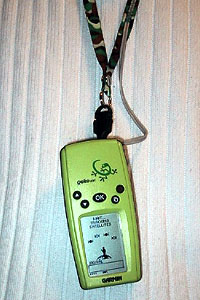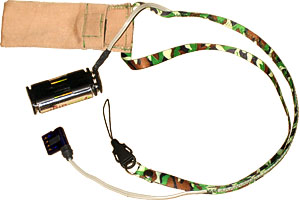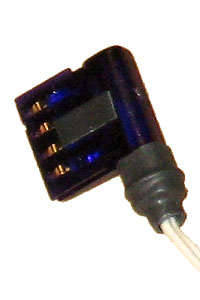

Inline Skating
 MiniDisc Hacks
MiniDisc Hacks
 PC Utilities
PC Utilities
 Free Games
Free Games
Extra battery pack for Garmin GPS
More power in extreme winter conditions
 Using a
small
GPS receiver can be a nightmare in winter conditions: To keep good
track of the position, the receiver cannot be kept under the winter
clothing; however, standard alkaline batteries lose their capacity in
freezing temperatures. As the result, it is difficult to keep small GPS
receivers (e.g. Garmin Geko) powered for example whole one-day
cross-country skiing trip. However, keeping the GPS continuously on is
important for accurate distance measurement, which is the most common
use for GPS on normal leisure skiing trips.
Using a
small
GPS receiver can be a nightmare in winter conditions: To keep good
track of the position, the receiver cannot be kept under the winter
clothing; however, standard alkaline batteries lose their capacity in
freezing temperatures. As the result, it is difficult to keep small GPS
receivers (e.g. Garmin Geko) powered for example whole one-day
cross-country skiing trip. However, keeping the GPS continuously on is
important for accurate distance measurement, which is the most common
use for GPS on normal leisure skiing trips.
This problem can be solved using lithium batteries as the Garmin user's guide recommends but such batteries are more difficult to find and probably more expensive than regular alkalines. The other way to solve the issue is to keep the batteries warm while the GPS receiver is still outside the clothing. This can be achieved with an extra battery pack.
 My solution
is to integrate the extra batteries in a neckband that can be used to
carry the receiver. A battery holder with two AA-size alkaline
batteries is inserted in a small pocket which is sewed to a neckband.
The pocket is closed with a small piece of Velcro. The battery pocket
is positioned so that it will be on the back of user's neck when the
GPS is hanging on
the front of the user; then it is easy to insert the battery pocket
under the clothing while keeping the neckband and the receiver on the
top of the clothes.
My solution
is to integrate the extra batteries in a neckband that can be used to
carry the receiver. A battery holder with two AA-size alkaline
batteries is inserted in a small pocket which is sewed to a neckband.
The pocket is closed with a small piece of Velcro. The battery pocket
is positioned so that it will be on the back of user's neck when the
GPS is hanging on
the front of the user; then it is easy to insert the battery pocket
under the clothing while keeping the neckband and the receiver on the
top of the clothes.
The power cable is guided along the neckband to the GPS receiver, where it has a connector that fits on the receiver's power connector. The power cable can be unplugged from the receiver and if the neckband has a quick detachment buckle, then the GPS receiver can be easily removed from the lace when required.
The pictures show the prototype designed for Garmin Geko 201. Before building one for your own GPS receiver, you need to check the following:

- Check the plug-in voltage of your GPS. Garmin Geko 201 tolerates only 3.0 ± 0.15 V; however, this can be obtained directly with two alkaline batteries. Other GPS receivers may need different voltages or more accurate regulation.
- Find a suitable connector. Garmin connectors can
be
obtained from your local Pfranc
dealer almost in every country. The e2plug form factor is the
best choice for most common Garmin receivers. (Note: The e2plug
connector
is not directly compatible with Geko receivers. You will need
to cut
off the small protruding tab from the connector and attach some
(rubber)
tape on the connector to make the connection more secure. See picture
on the left.)

- Look at the user's guide of your GPS. Most receivers indicate that they are running on external power supply. For example, the battery symbol on Garmin Geko receivers will be replaced with plain four dots.
- Do not forget the backlight on. At least Garmin Geko
201
has an annoying feature that the backlight is not switched
automatically off if the unit is running on external power. As far as I
know, there is no way to make the backlight to timeout when extra
battery pack is connected like it does when internal batteries are used.

